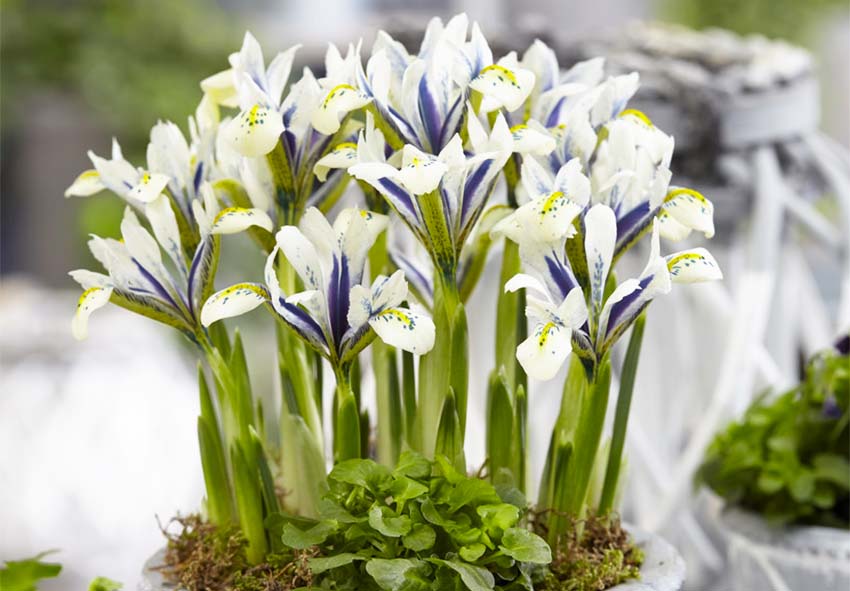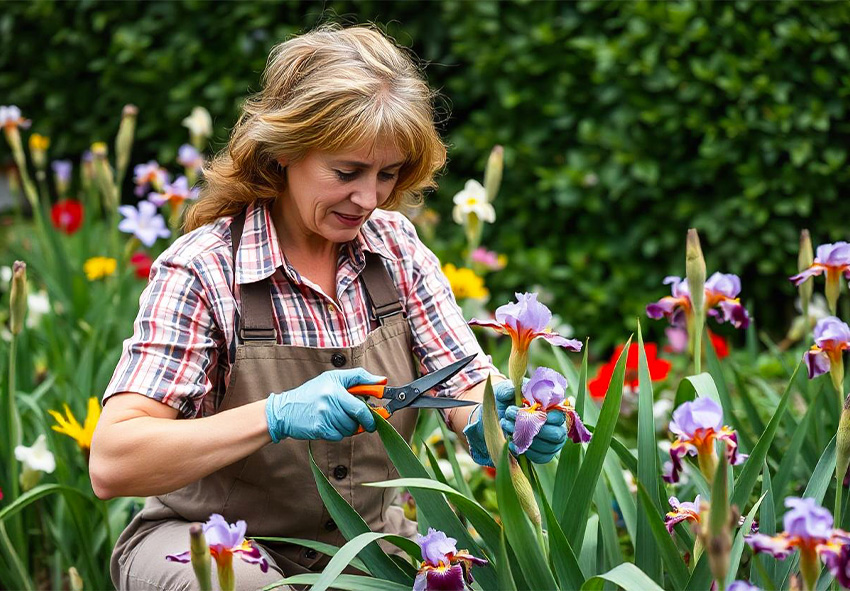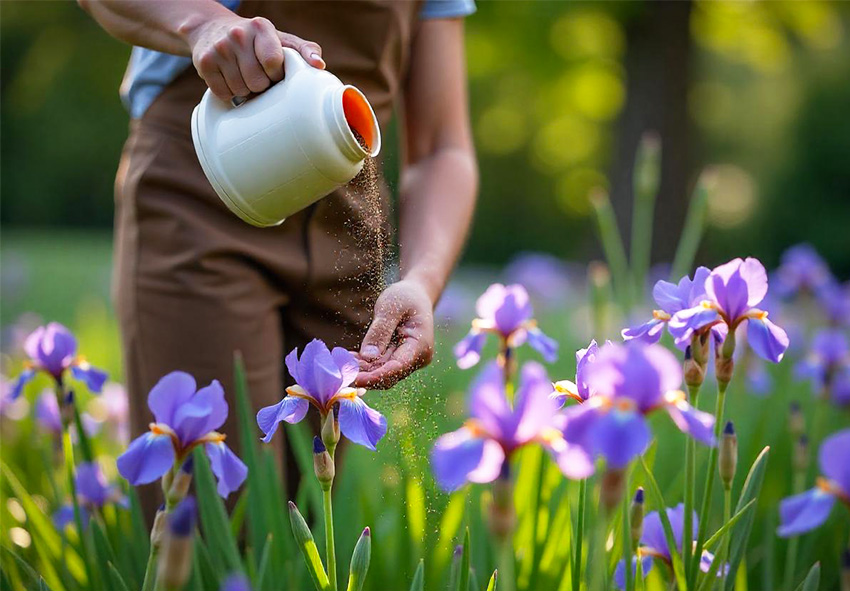After irises finish blooming, proper care is crucial to ensure healthy plants and vibrant flowers next season. Understanding what your irises need post-bloom can prevent diseases, encourage strong roots, and promote more prolific flowering. This guide will cover everything from pruning and deadheading to dividing and seasonal care, giving your irises the best chance for success. Our gardening blog is a perfect place to find all the information you need!
Understanding Irises After Blooming

Knowing what happens to irises after blooming is key to maintaining their health. Proper post-bloom care can directly influence flower size, rhizome strength, and overall plant longevity.
What Happens to Irises Once Flowers Fade
Once iris blooms fade, the plant redirects its energy from flowers to root and rhizome development. Failing to manage the foliage can lead to weak growth or susceptibility to disease. Observing these changes helps you take the right steps for healthy plants.
Why Post-Bloom Care is Essential for Next Season
Proper post-bloom care is crucial for ensuring your irises thrive in the following season. After flowers fade, the plant focuses on storing nutrients and strengthening its rhizomes. Skipping this care can lead to weaker blooms, increased disease risk, and poor overall plant health. Here are the key reasons why post-bloom care is essential:
- Nutrient Storage for Next Year: After blooming, irises store energy in their rhizomes. Proper care ensures these nutrients are not wasted, resulting in larger and healthier flowers next season.
- Prevention of Disease: Removing spent blooms and trimming yellowing leaves reduces the risk of fungal infections and pests. Clean, healthy foliage helps the plant remain strong during dormancy.
- Encourages Strong Root and Rhizome Development: Post-bloom care promotes root growth, allowing the plant to absorb water and nutrients efficiently. Strong rhizomes lead to more vigorous flowering in the next cycle.
- Maintains Garden Aesthetics: Deadheading and pruning not only benefit plant health but also keep your garden looking neat and attractive. Tidiness reduces plant stress and makes it easier to spot potential problems.
- Prepares Plants for Seasonal Changes: Proper care after blooming helps irises adjust to summer and fall conditions. Mulching, watering, and monitoring foliage prepare the plant for dormancy and ensure it survives winter successfully.
Pruning Irises After Blooming
Pruning irises is an important step after flowering to maintain plant health. Removing spent blooms and old foliage encourages strong root growth and prevents disease.
When to Prune Irises
Pruning should be done soon after flowers fade, usually in late spring or early summer. This timing prevents energy waste on old blooms and keeps the plant tidy. Observing the foliage’s color and condition helps determine the ideal pruning moment.
How to Cut Back Foliage Correctly
Trim flower stalks to the base but leave healthy leaves intact. This allows the plant to continue photosynthesis while focusing on root and rhizome growth. Avoid cutting green leaves until they are naturally yellow.
Common Pruning Mistakes to Avoid
Pruning too early or cutting healthy foliage can stress the plant. Using dull tools can damage rhizomes and spread disease. Always sanitize your tools and follow proper cutting techniques for safe pruning.
Deadheading Irises for Continued Health
Deadheading irises helps redirect plant energy from seed production to root and rhizome development. Regular removal of spent blooms also improves the overall appearance of your garden.
Benefits of Deadheading Irises
Deadheading removes spent flowers, preventing seed formation and conserving plant energy. It improves air circulation and reduces the risk of fungal infections. Regular deadheading keeps your garden looking neat and vibrant.
Step-by-Step Guide to Deadheading

Cut flower stalks just above the base of the plant using clean, sharp scissors. Remove any fallen petals around the base to prevent decay. Repeat the process for all spent blooms throughout the season.
Tools Needed for Effective Deadheading
A pair of garden shears or scissors is essential. Gloves protect your hands from sharp foliage edges. Using sterilized tools reduces the spread of pests and diseases.
Dividing Irises After Blooming
Dividing irises ensures healthy growth and prevents overcrowding. It’s a critical step for maintaining vigorous blooms and strong rhizomes year after year.
Signs Your Irises Need Dividing
Crowded rhizomes, reduced bloom size, or poor flowering indicate it’s time to divide. Dividing improves airflow and reduces disease risk. Check your garden every few years to assess rhizome health.
Best Time to Divide Irises
Late summer, after foliage begins to yellow, is ideal for division. The plant is less stressed, and rhizomes have stored enough nutrients. Avoid dividing in early spring to prevent damaging new growth.
Step-by-Step Division Process
Dividing irises after blooming is one of the most effective ways to keep them healthy and ensure abundant flowering. This process helps rejuvenate older clumps, prevents overcrowding, and encourages stronger growth. Here are the basic steps to follow.
- Dig Up the Clump: Carefully lift the iris clump from the soil using a garden fork or spade.
- Separate Rhizomes: Break or cut apart the rhizomes, keeping only the firm, healthy sections.
- Trim Leaves: Cut foliage back to about one-third of its height to reduce stress on the plant.
- Replant Divisions: Place rhizomes shallowly in prepared soil, spacing them to allow good airflow and future growth.
Iris Care Tips After Blooming
Just like care for irises after planting, proper care after blooming sets the foundation for next year’s growth. Attention to watering, fertilization, and pest prevention ensures irises remain strong and healthy.
Watering Needs After Blooming
Continue to water irises consistently, especially during dry spells. Avoid waterlogging, as rhizomes are prone to rot. Well-watered rhizomes store nutrients efficiently for next season.
Fertilization Guidelines for Strong Roots
Apply a balanced fertilizer after blooming to promote root development. Avoid high-nitrogen fertilizers, which encourage leaf growth at the expense of rhizomes. Regular feeding supports vibrant flowers in the following spring.
Pest and Disease Prevention in Late Season
Inspect leaves and rhizomes for signs of pests like iris borers. Remove affected leaves promptly and consider natural remedies. Maintaining clean garden beds reduces the risk of fungal infections.
Preparing Irises for the Next Bloom Cycle

Preparing your irises for the next bloom cycle helps ensure strong flowers and healthy rhizomes. Seasonal maintenance is crucial for long-term plant success. Here are some preparation tips for you:
- Seasonal Care in Summer and Fall: Keep foliage trimmed and mulch around the base to protect roots. Remove weeds to prevent nutrient competition. Monitoring soil moisture ensures rhizomes remain healthy through the dormant season.
- Winter Protection for Iris Rhizomes: In colder regions, apply a light layer of mulch or straw to insulate rhizomes. Remove mulch in early spring to avoid rot. Proper winter care reduces frost damage and prepares irises for vigorous growth.
- Encouraging Bigger Blooms Next Spring: Regular division, proper fertilization, and consistent watering all contribute to larger flowers. Healthy rhizomes produce stronger stalks and more blooms. Follow post-bloom care steps diligently for maximum flowering potential.
Conclusion
Caring for irises after blooming is crucial for long-term garden success. By pruning, deadheading, dividing, and following seasonal care tips, you ensure vibrant flowers year after year. With these techniques, your irises will thrive, providing beauty and color for seasons to come!
Frequently Asked Questions (FAQs) about Irises After Blooming
1. Why is post-bloom care important for irises?
Post-bloom care is crucial because it helps irises store energy for next year’s flowers. Removing spent blooms and maintaining healthy foliage ensures the plant can photosynthesize effectively. Without proper care, irises may produce fewer blooms or become vulnerable to pests and diseases in the following season.
2. Should I cut back iris leaves after flowering?
You should not cut back iris leaves immediately after flowering. The foliage continues to absorb sunlight, which strengthens the rhizomes for future growth. Only remove leaves if they are yellow, diseased, or damaged. In late fall, trim them down to about 6 inches to prepare the plant for winter.
3. How often should irises be divided after blooming?
Irises typically need division every 3–5 years, depending on how quickly they spread. Division after blooming prevents overcrowding, which can limit flowering. It also helps rejuvenate the plants and improves air circulation around the rhizomes, reducing the risk of rot and other issues.
4. Can I order Dutch Irises from your online store?
Yes, you can! Our online store Dutch-bulbs.com offers a wide selection of Dutch Irises, including different varieties and colors. We take pride in providing top-quality plants that are carefully cultivated and shipped with care to ensure they reach you in perfect condition. Place your order now and receive the finest flowers.
5. Do irises need fertilizing after they bloom?
Yes, fertilizing irises after they bloom can be beneficial. A low-nitrogen fertilizer applied around the base encourages rhizome development without stimulating excessive leaf growth. Feeding at this stage helps prepare the plant for the next blooming cycle and keeps the clumps strong and healthy.
Published: 16.09.2025
